Yosemite National Park is spectacular any time of year, from roaring waterfalls in the spring to dreamy snowscapes in winter. So, when is the best time to visit Yosemite? It all depends on what you want to do and experience, with each season offering its own perks and advantages.
This season-by-season guide explores the best time to visit Yosemite, including both activities and highlights, pros and cons for each time of year.
Note: Yosemite requires reservations for entry at various points during the year, including February Firefall and summer peak season. Always check the current reservation requirements for the dates you plan to visit.
Additionally, the Mist Trail, along with parts of the John Muir Trail and Panorama Trail, is closed past Vernal Falls for trail work on Mondays and Thursdays through early December 2025. You can learn more here.
Jump to:
Spring (April – June)
Go for: thundering waterfalls, pleasant weather
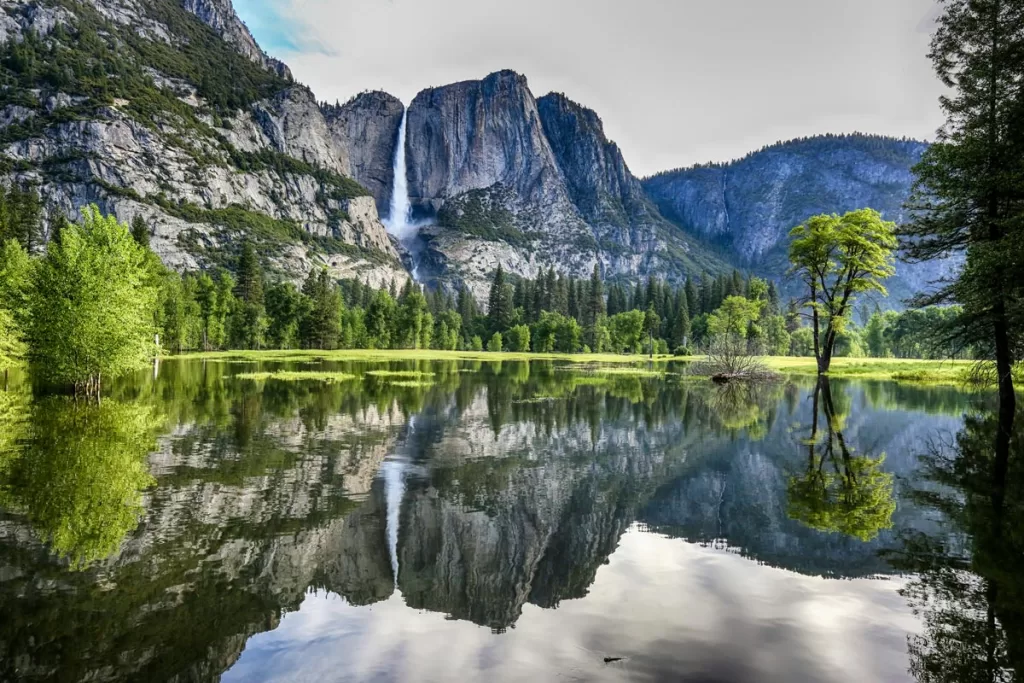
Spring is the best time to visit Yosemite if you want to witness the power of its famous waterfalls.
Snowmelt from higher elevation intensifies its water flow to thundering cascades, with the “big four” – Bridalveil Fall, Yosemite Falls, Vernal Falls and Nevada Falls absolutely roaring this time of year.
Things to Do in Yosemite in Spring
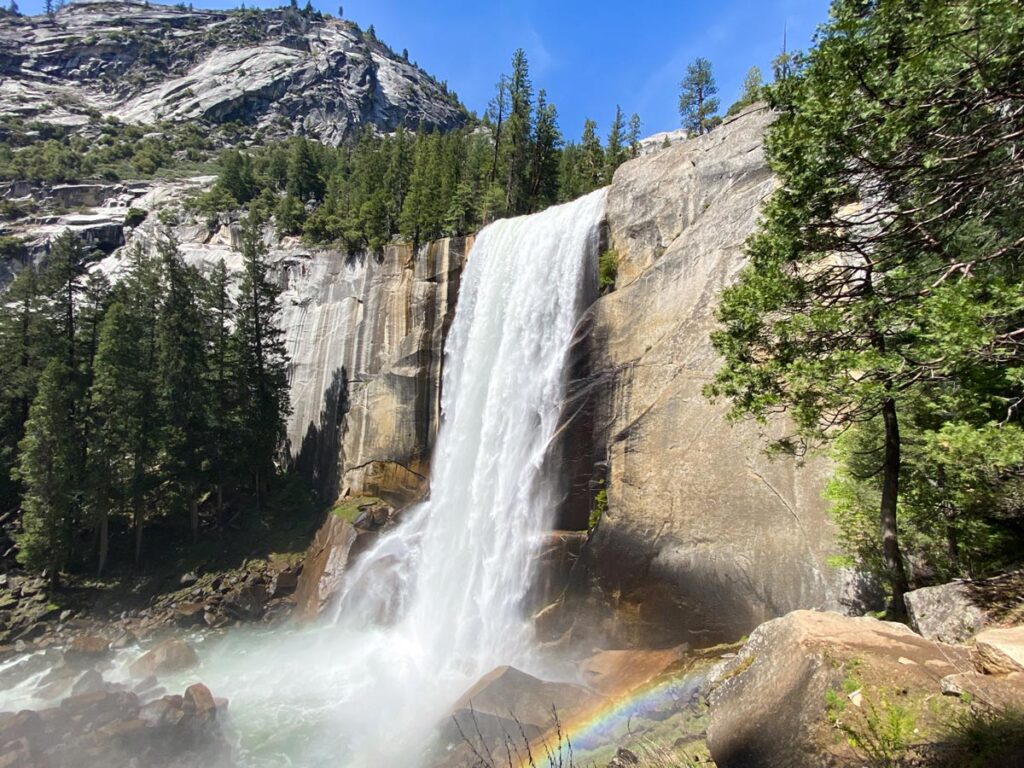
- Hike the Mist Trail to Vernal and Nevada Falls. The Mist Trail is one of Yosemite’s most popular hikes, and gets you in spitting distance of Vernal Falls first (2.4 miles roundtrip from the trail head) with Nevada Falls further up the trail (5.4 miles roundtrip). Plan for crowds and slippery rocks this time of year, and be prepared to get wet from the waterfalls’ spray.
- Stroll to Lower Yosemite Falls. This flat, paved 1.2-mile loop in Yosemite Valley is suitable for all ages and abilities. It leads you directly to the base of North America’s tallest waterfall.
- Walk the Bridalveil Fall loop. Another accessible trail, 0.7-mile Bridalveil completes the group of waterfalls in Yosemite Valley.
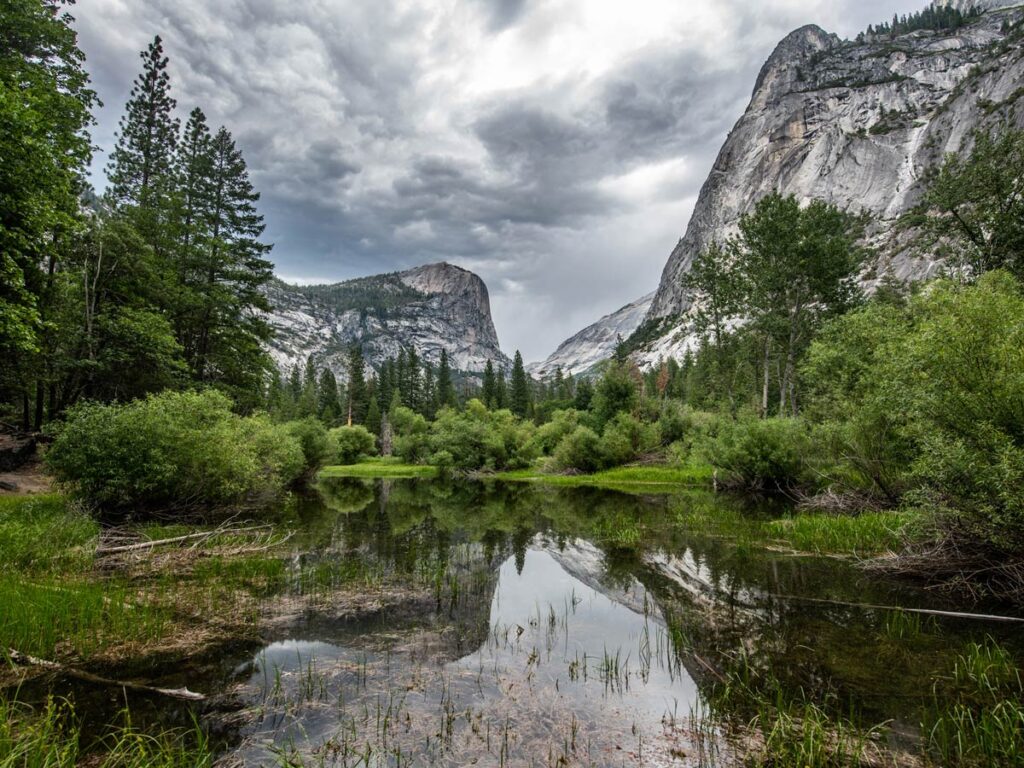
- Hike to Mirror Lake. Tucked back against the foot of Half Dome, this serene lake is especially lush in the spring, with new growth in vivid green hues. The trail itself (4.4 miles roundtrip) is fairly flat and sits at low elevation in Yosemite Valley, making it accessible earlier in the season than some other hikes.
- Bike through Yosemite Valley. Bike rentals are available for a different perspective of Yosemite Valley. Enjoy 12 miles of flat, groomed bike trails that wind through verdant forests and along lush meadows. And while it’s a great summertime activity too, if you go in spring you’ll still get pleasant biking weather but without so many crowds. You can learn more about bike rentals here.
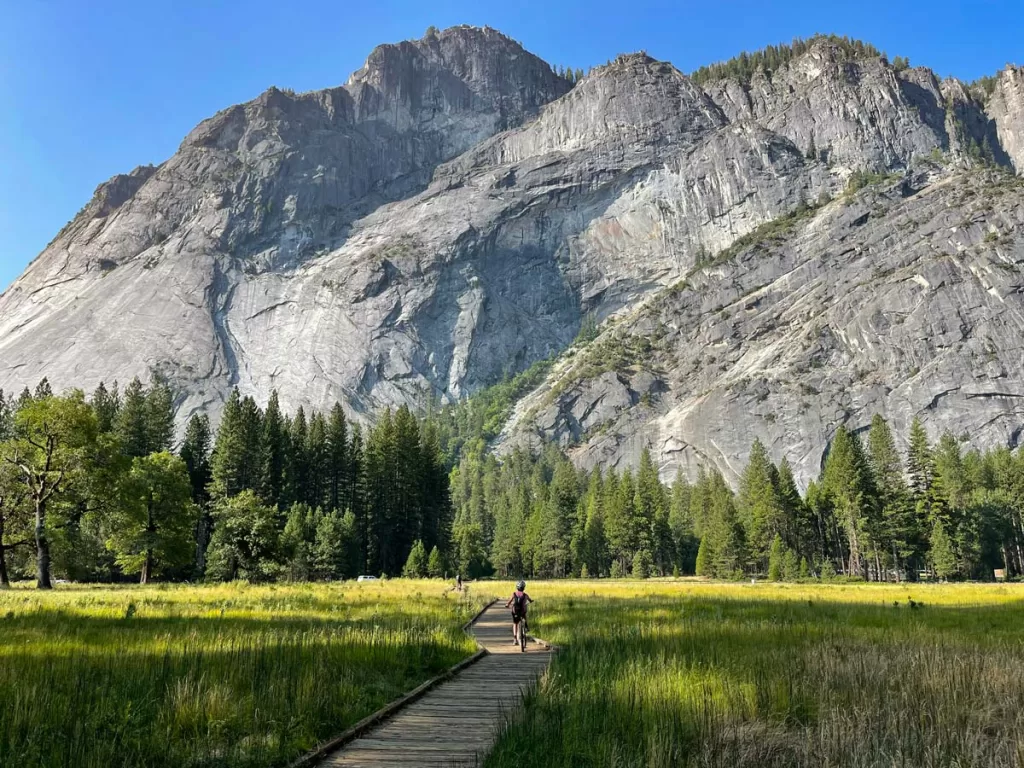
Drawbacks of Visiting Yosemite in the Spring
Waterfall season draws crowds, so book travel early and expect to share the roads and trails.
Additionally, roads leading from Yosemite Valley to higher elevation (including Glacier Point Road and Tioga Road) are typically closed through May.
Usually, Glacier Point Road is accessible by mid-May, while Tioga Road opens by early June (depending on the season’s snowfall). If you want to visit Tuolumne Meadow, Tenaya Lake, and other High Sierra favorites, you’re better waiting until June.
Summer (July – September)
Go for: water activities, wildflowers, extended hiking, High Country access
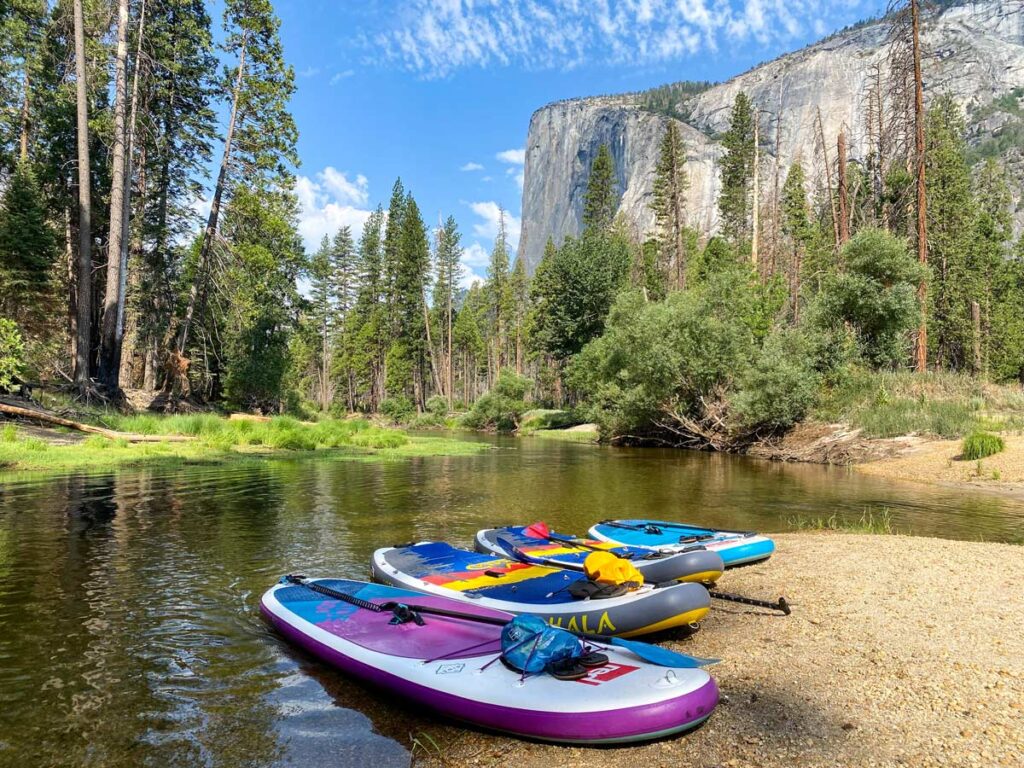
Summer in Yosemite is positively sublime. From sparkling alpine lakes to cheerful bursts of wildflowers, this is the best time to visit Yosemite if you want to experience the park at its fullest.
However, summer is also peak travel season, and the park gets extremely crowded. Expect to share the roads and trails – and don’t rule out a traffic jam near Yosemite Village.
Things to Do in Yosemite in Summer
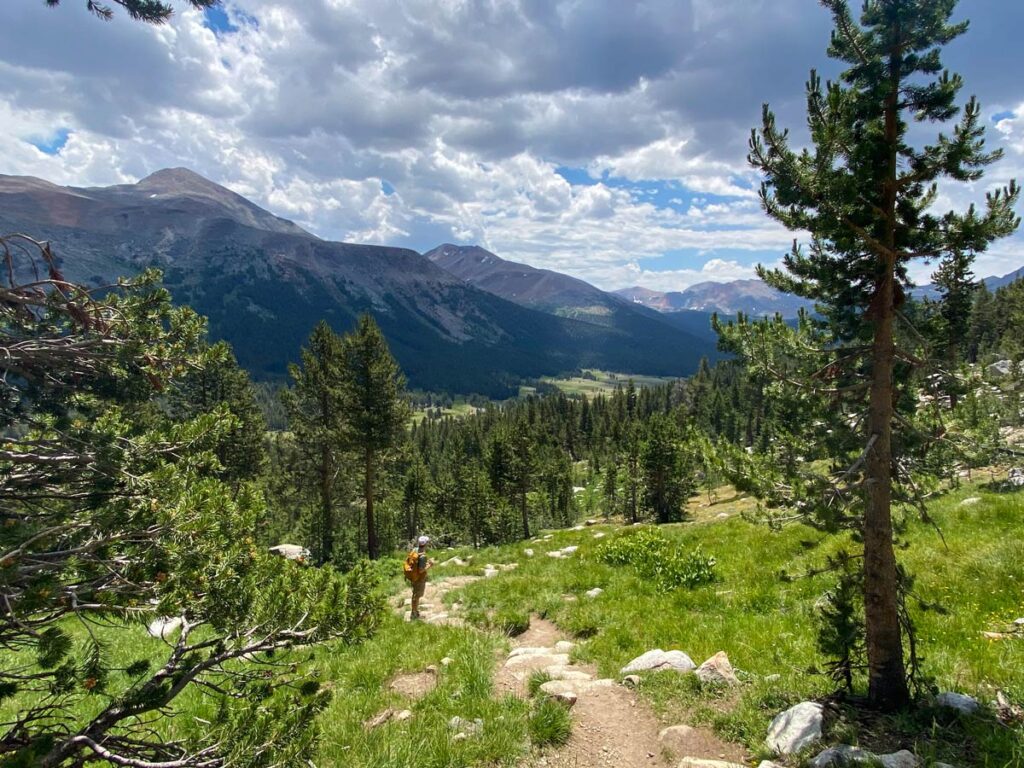
- Go for a hike. All trails are open during the summer months. One of the park’s most popular hikes is the Mist Trail, which gets you up close to Vernal and Nevada Falls (2.4 – 5.4 miles roundtrip). For an easy stroll, loop along the flat (and often paved) paths through Yosemite Valley, including Lower Yosemite Falls and Cook’s Meadow. Alternately, those wanting a more strenuous day hike can explore Upper Yosemite Falls (6.6 miles roundtrip), Clouds Rest (12.2 miles) or our personal favorite, Glacier Point to Yosemite Valley (8.6 miles). You can read more at our guides to the best easy, moderate, and hard hikes in Yosemite.
- Explore the High Country. The ecosystem of the High Sierra is entirely different from Yosemite Valley, with jagged peaks and a stark, more windswept beauty. Venture up to sprawling Tuolumne Meadows, before exploring some of the trails at higher elevation. Middle Gaylor Lake is a strenuous but quick hike (2.4 miles roundtrip), while Cathedral Lakes (8.6 miles roundtrip) is one of the most popular longer distance hikes.
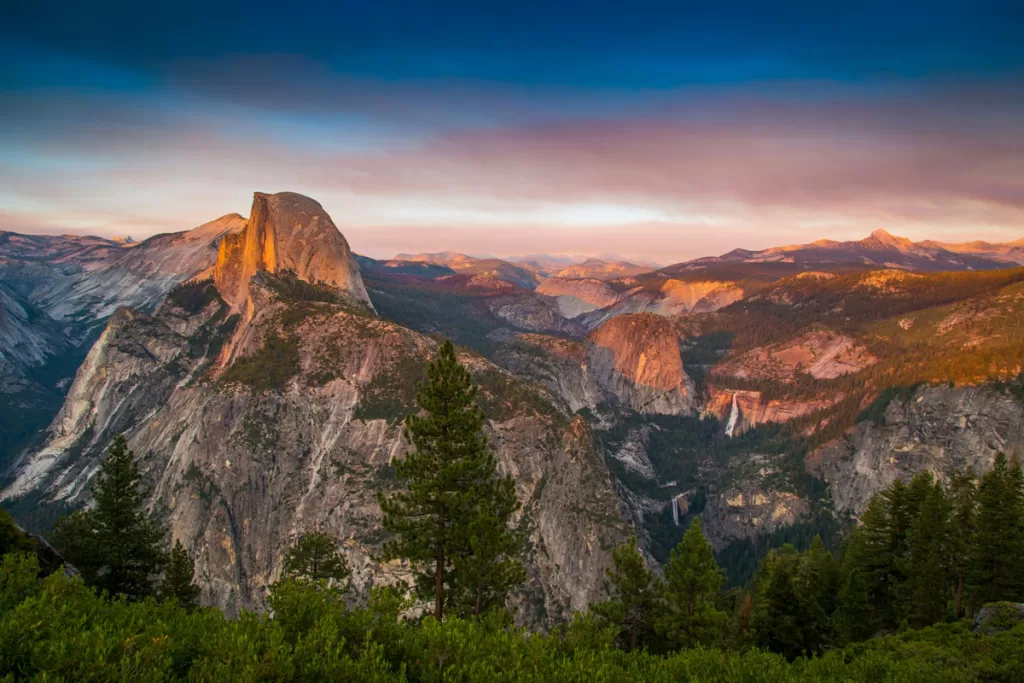
- Marvel at Glacier Point and Taft Point. After the annual winter closure, Glacier Point Road is fully open by the summer months. It leads to Glacier Point, one of the most awe-inspiring viewpoints in the park. Here, Half Dome looks close enough to touch, with a backdrop of mountain peaks stretching to the horizon. Just 2.5 miles down the road is Taft Point, the most dizzying (some may say “adventurous”) overlooks, with a promontory jutting out 3,500 feet over Yosemite Valley below.
- Swim in Tenaya Lake. Located along Tioga Road (on the way up to Tuolumne Meadows), Tenaya is a sparkling high alpine lake with plenty of shoreline for picnicking and lounging. Swimming and paddle boarding are heavenly on a hot summer day (you’ll just need to bring your own boards).
- Enjoy a beach day in Yosemite Valley. Sentinel Beach has a sunny, sandy shoreline along the Merced River, with a front-row view of Yosemite Falls. A bit further west along the valley floor is Cathedral Beach, which sits in the shadow of towering El Capitan. Both beaches have picnic tables and easy water access, for a cooling dip in the Merced.
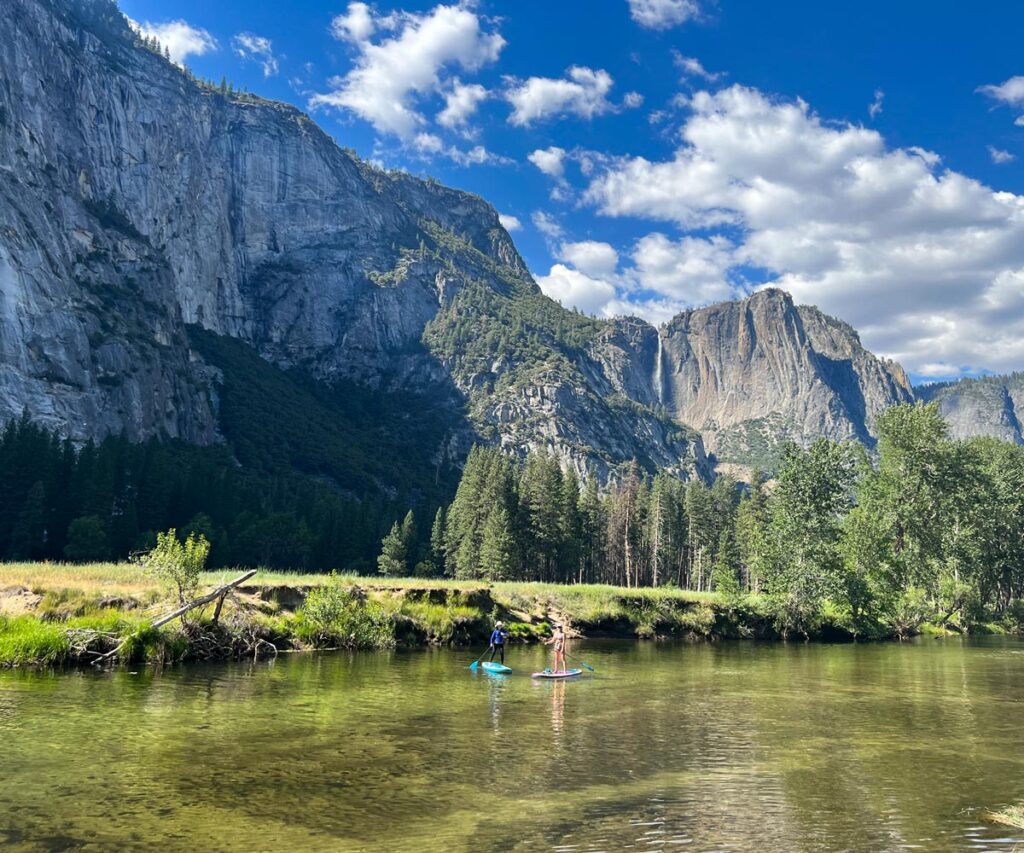
- Float the Merced River. After the rushing torrent of spring snowmelt, the Merced River slows to a placid stream during the summer months. If you have your own paddleboards, you can paddle the length of Yosemite Valley (read more about paddle boarding here), otherwise you can rent rafts at Curry Village.
- Join a ranger-led program. Yosemite offers a multitude of ranger-led classes and programs to round out your knowledge of the park. Topics include everything from nature walks and history lectures, to photography and art classes. You can learn more and see what’s offered during your visit here.
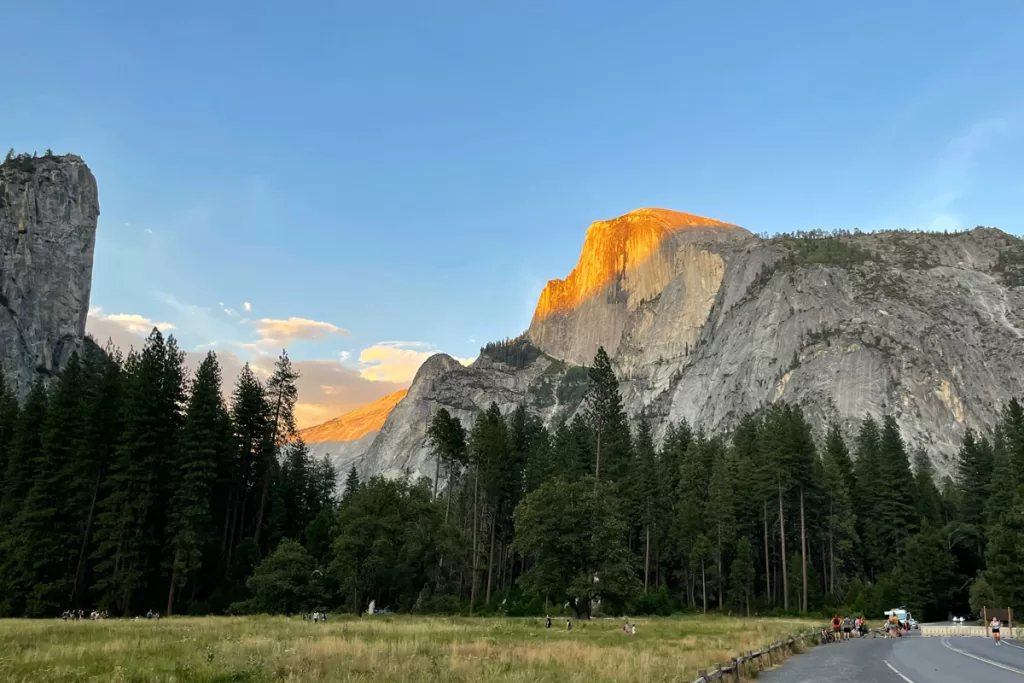
Drawbacks of Visiting Yosemite in Summer
Crowds, crowds, crowds.
Yosemite Valley can feel like Disneyland in the summer months, although the park’s new reservation system has made some strides in lessening the seasonal overcrowding.
If you need to escape the hordes, you can find solace at the park’s higher elevations, like Tuolumne Meadow and the high country.
When visiting in the summer, we recommend booking your travel well in advance. The most popular hotels open their reservations one year out, while campsites become available five months ahead. (Campsite reservations are highly competitive – you can learn more about securing a site here.)
Also, make sure you have an entrance reservation for your planned dates.
Fall (October – November)
Go for: less crowds, fall color, hiking without the heat

October and November are shoulder season in Yosemite. Days are crisp and cool, but the park most likely has yet to see its first snowfall. To avoid crowds or heat, fall is a great time to visit.
While it’s too cold for swimming and water activities, you can still enjoy nearly everything else that the park also offers in the summer months. Just keep an eye on current conditions, as Tioga Road and Glacier Point Road often close by November.
Things to Do in Yosemite in Fall
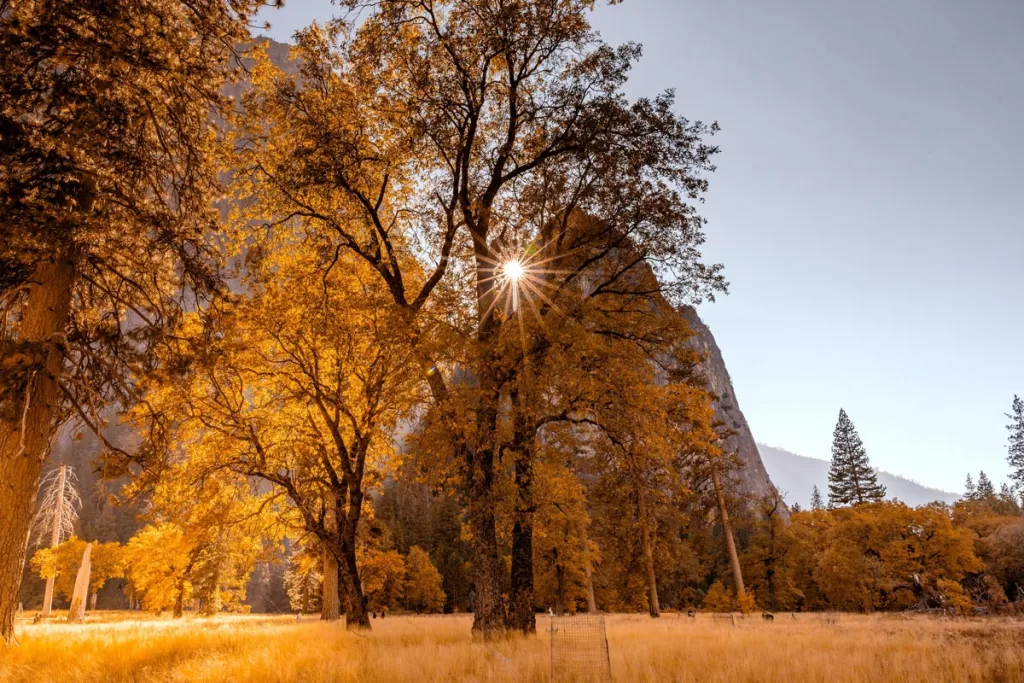
- Marvel at the fall color. Autumn turns the park into a sea of burnt oranges, deep reds, and vivid yellows. Color begins turning at the higher elevations first, before working its way down to Yosemite Valley (typically by mid to late October). CaliforniaFallColor.com is a great resource for up-to-date status reports. It refreshes weekly during the fall months, to help maximize your chances of capturing peak fall foliage.
- Go for a longer hike. We find fall to be one of the best times to visit Yosemite for extended hiking. The weather is still pleasant, but a morning nip in the air keeps temperatures cooler throughout the day, and your endurance won’t wilt under the heat. Cathedral Lakes (8.6 miles roundtrip) can be delightful in October (assuming Tioga Road is still open), while serious hikers may enjoy the views from Cloud’s Rest (12.2 miles).
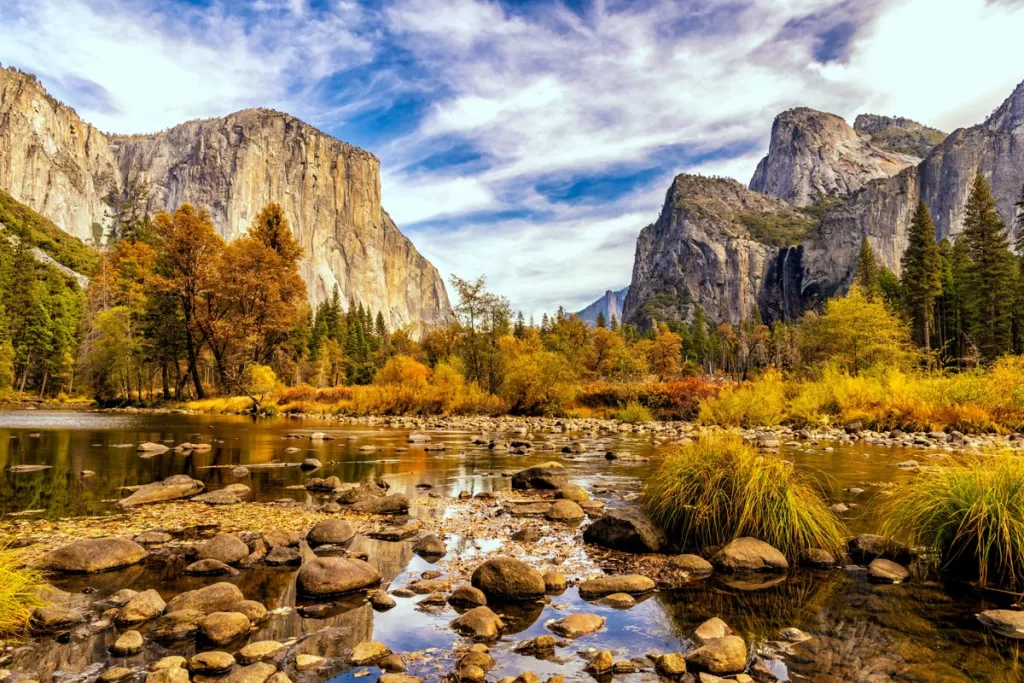
- Enjoy an evening picnic in El Capitan Meadow. While picnicking is a great activity any time between spring and fall, the season’s soft light makes this experience particularly memorable during the cozy autumn months. Park along Northside Drive in the shadow of El Capitan (directions), at least an hour before sundown. Be sure to bring a blanket or chairs, and snacks – you can either bring your own, or pick up provisions at the Yosemite Valley Village Store. Settle into the grassy meadow, and watch as the evening’s rosy alpenglow descends across the iconic granite face of “El Cap.”
Drawbacks of Visiting Yosemite in the Fall Months
Shoulder season brings uncertainty, as you never know exactly when winter will arrive any given year. It can make travel planning more challenging.
While weather is usually consistent through early to mid October, you should remain flexible if you’re visiting later in October or November.
Winter (December – March)
Go for: skiing, ice-skating, general winter wonderland vibes
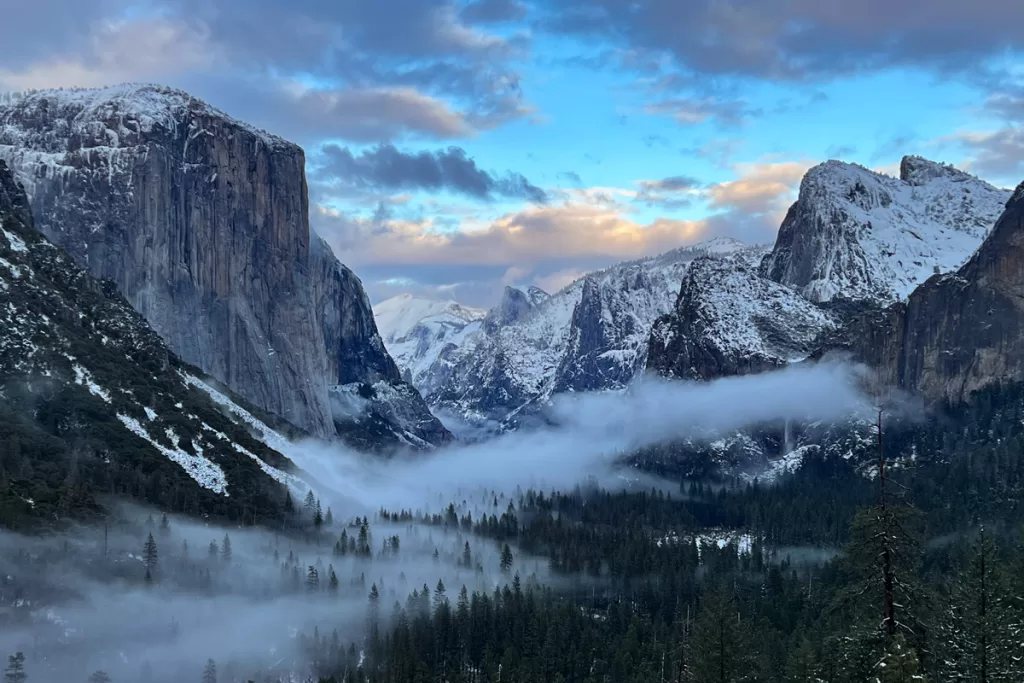
Yosemite Valley sits at a surprisingly low elevation (only 4,000 feet), so it doesn’t always see snow during the winter. However, when a storm passes through, it turns the valley into a veritable winter wonderland, with a serene stillness draped across the snowy landscape.
During the winter months, road closures will prevent you from seeing much of the park outside of Yosemite Valley, but there are plenty of seasonal activities to keep you occupied in the park’s primary hub.
Things to Do in Yosemite in Winter
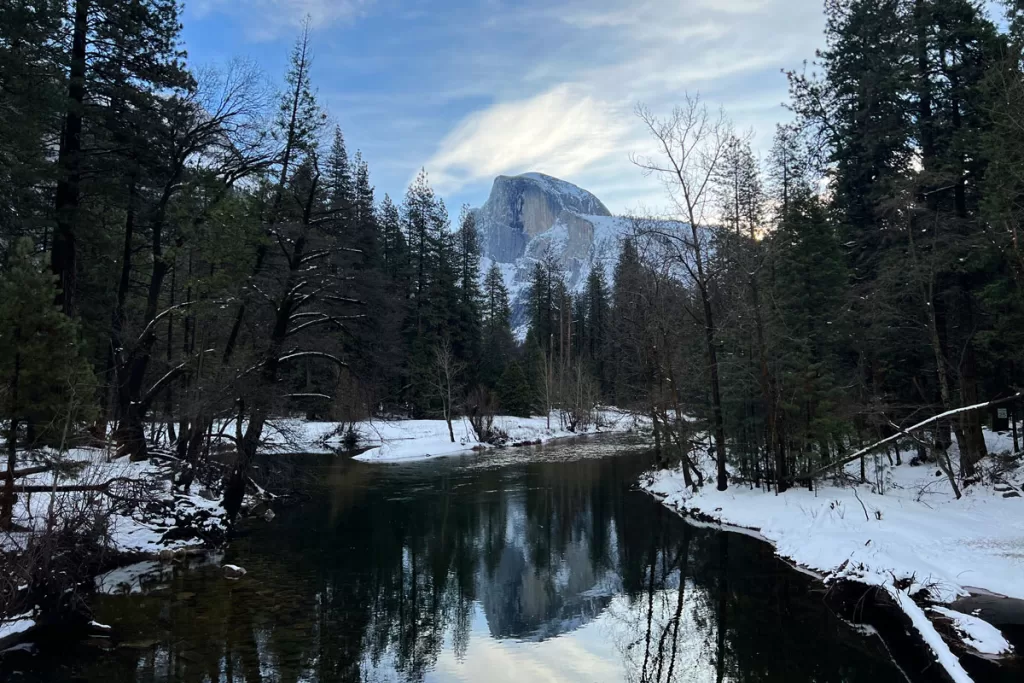
- Ski or snowboard at California’s oldest ski resort. Family-friendly Badger Pass is not large, but its slopes carry a weighty history. Open from mid-December to mid-March, you’ll find both downhill and cross-country skiing, snowboarding, tubing, and more. Learn more at the Badger Pass website.
- Ice skating at Curry Village. Each winter, an outdoor ice-skating rink sprouts in the shadow of Half Dome. It’s a postcard-perfect venue, typically open from late November to early March. Check out rentals, skate sessions, and other info at the rink website.
- Snowshoe amongst the world’s largest trees. Mariposa Grove is home to the giant sequoia – the largest tree in the world, that only grows in a small footprint within California. The grove is closed to vehicular traffic in winter, but you can still cross-country ski or snowshoe in, experiencing the solitude of these stately giants under a gentle brushing of snow. If you don’t have your own gear, you can rent snowshoes, skis, and poles at the Nordic Center at Badger Pass.
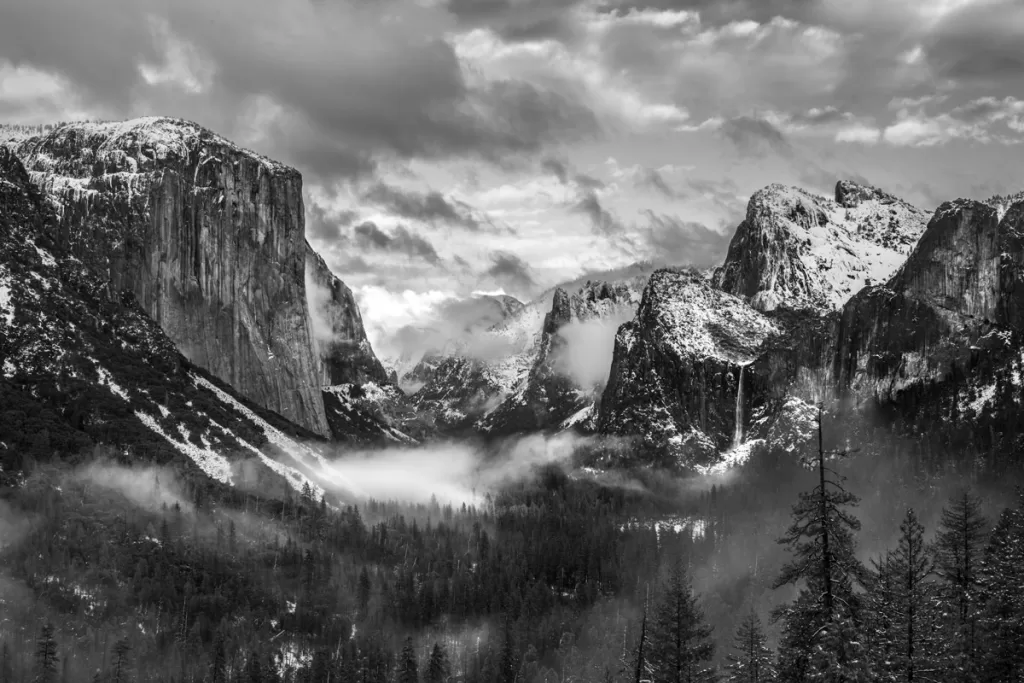
- Capture dramatic winter photographs. Snow and lingering clouds create dramatic seasonal photos, especially black and white images that emulate famed Yosemite photographer Ansel Adams. Nature photographers will enjoy playing with the moodiness of the landscape, especially at famed vistas like Tunnel View (above) and El Capitan Meadow. You can discover more photography locations at our guide to the best photo spots in Yosemite.
- Cozy up at the famed Ahwahnee Lodge. This stately lodge has hosted celebrities, world leaders, and commoners alike for over a hundred years. And while it’s open year-round, the richly-paneled lounges and roaring fireplaces are especially atmospheric in the winter months. You don’t need to be a guest to cozy up here – the hotel common areas, with an on-site restaurant and bar, are open to the public.
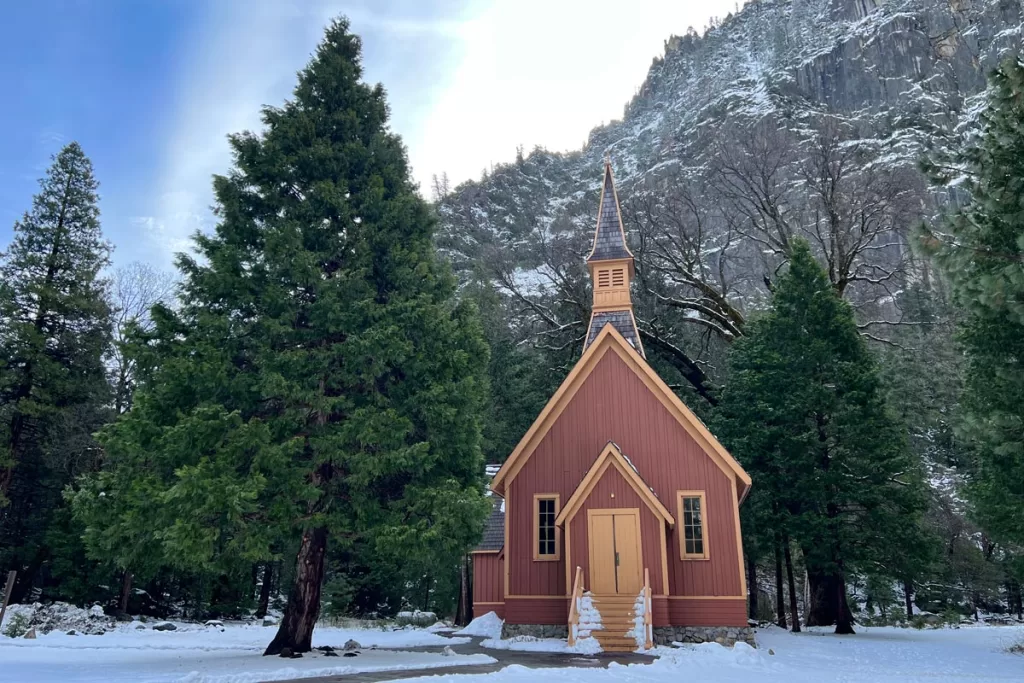
Drawbacks of Visiting Yosemite in Winter
Winter weather can create hazardous conditions, and you won’t be able to access Tioga Road or Glacier Point Road.
Always take extra precautions during the winter months: check weather and current park conditions prior to travel, and have tire chains on hand.
